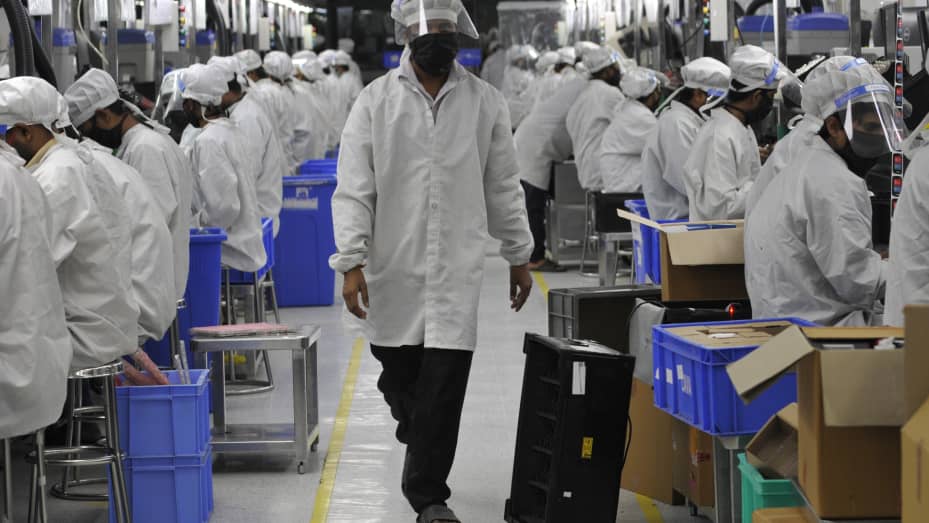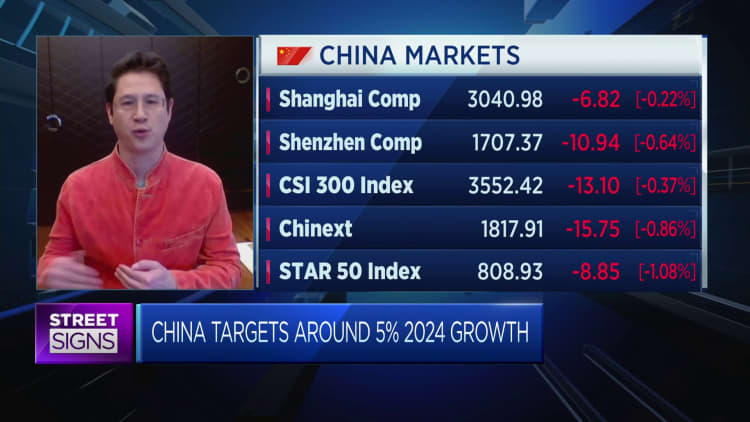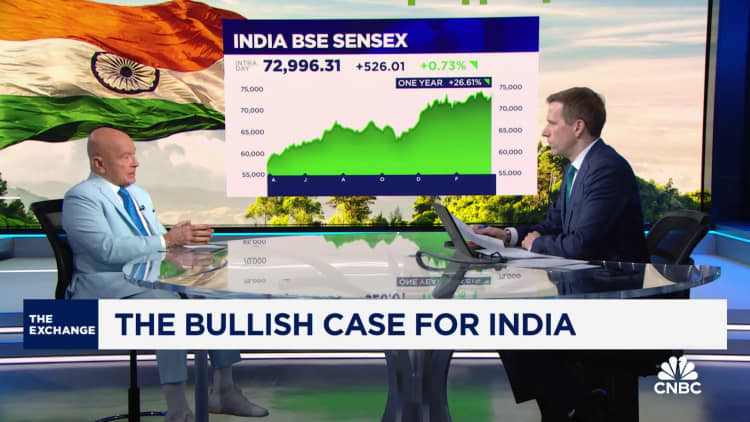風蕭蕭_Frank
以文會友印度希望成為中國的頂級製造業替代品. 但首先它需要擊敗越南
佘詩曼·雅各布 2024 年 4 月 1 日
關鍵點
隨著企業撤離中國,印度希望成為亞洲最大的製造商,但首先它需要取代越南。
分析人士指出,印度要想追平甚至超越越南的製造業實力,必須解決兩個最大的問題——降低進口稅和提高供應鏈效率。
盡管麵臨這些挑戰,越南與中國的友好關係可能對印度來說是一個優勢。
印度諾伊達 - 5 月 12 日:2020 年 5 月 12 日,印度諾伊達第 63 區的 Lava 手機製造工廠在放鬆封鎖限製後恢複工作。 智能手機製造商 Lava 周六表示,在獲得當局允許開始有限運營後,該公司諾伊達工廠已恢複生產。 該公司已開始運營,產能達20%。 目前,該公司擁有 3,500 名員工,其中有 600 名員工。
印度諾伊達 Lava 手機製造工廠的工人。印度斯坦時報| 印度斯坦時報| 蓋蒂圖片社
隨著企業撤離中國,印度希望成為亞洲最大的製造商,但如果它想取代越南,首先需要降低稅收並提高供應鏈效率。
隨著與中國的競爭加劇,美國推行了“友好外包”議程。 拜登政府鼓勵美國公司將電子和技術製造業務從中國轉移到更友好的國家,特別是亞太地區的越南和印度。
“民主黨和共和黨都將中國視為挑戰。 美國的每個董事會都在詢問首席執行官他們的規避中國風險的戰略是什麽,”美印戰略夥伴關係論壇主席兼首席執行官穆克什·阿吉(Mukesh Aghi)表示。
越南領先
印度和越南對於外國投資者和公司來說是有吸引力的製造替代品,部分原因是勞動力成本低廉。 然而,在兩者之間,越南仍遙遙領先,2023 年出口總額為 969.9 億美元,而印度為 756.5 億美元。
“越南以其電子產品製造能力而聞名。 印度剛剛進入這場遊戲,因此這為越南提供了競爭優勢。”印度指數首席執行官兼沃格爾集團管理負責人薩米爾·卡帕迪亞 (Samir Kapadia) 表示。
雖然印度與美國的關係有所升溫,特別是在印度總理納倫德拉·莫迪 6 月對白宮進行國事訪問之後,但越南自 2007 年以來一直與華盛頓達成貿易和投資協議。
戰略家表示,下一個中國不是印度或越南,它仍然是中國
越南的另一個關鍵優勢是與印度相比更簡單,阿吉指出,印度有“29 個州,每個州都有可能不同的政策”。
軟件公司 Coupa 供應鏈戰略高級總監納裏·維斯瓦納坦 (Nari Viswanathan) 表示:“越南在規模經濟方麵具有優勢,製造業主要是體力勞動。”
維斯瓦納坦指出,服裝製造等需要密集體力勞動且利潤率低的行業“不會對印度產生任何影響”。
美國科技巨頭越來越多地將其部分供應鏈轉移到這個南亞國家。 英國《金融時報》去年 12 月報道稱,蘋果公司告訴零部件供應商,它將從印度工廠為其即將推出的 iPhone 16 采購電池。自 2016 年首席執行官蒂姆·庫克 (Tim Cook) 拜訪印度總理納倫德拉·莫迪 (Narendra Modi) 以來,該公司一直在考慮擴大在印度的業務。 穀歌還計劃於第二季度開始在印度生產 Pixel 手機。
進口關稅仍然居高不下
印度製造中心雄心壯誌的障礙之一是該國對信息和通信技術征收 10% 的進口關稅。 VinaCapital 首席投資官 Andy Ho 表示,這高於越南 5% 左右的平均進口關稅。
印度的進口稅旨在保護國內製造商,但降低這些關稅將是政府吸引外國公司在該國製造商品的努力的一部分。
卡帕迪亞補充道:“2024 年,莫迪總理將逐步取消其中許多關稅,但他將重點針對各個行業,而不是各個國家。”
例如,印度一月份將用於製造手機的某些金屬和塑料部件的進口稅從 15% 降低至 10%。 這有利於蘋果和 Dixon Technologies 等公司,後者為小米、三星和摩托羅拉生產手機。
“鑒於越南在電子產品製造和向全球出口方麵的強勢地位,
在美國,隨著印度試圖奪取市場份額,我們將在早期看到最大的吸引力。 這包括各種塑料、金屬部件和機械物品,”卡帕迪亞說。
印度蜂窩和電子協會主席 Pankaj Mahindroo 在 LinkedIn 上發帖稱,去年 1 月至 9 月,印度對美國的電子產品出口額達到 66 億美元,而 2022 年同期為 26 億美元。
但 VinaCapital 的 Ho 警告稱,降低進口關稅“並不是長期吸引 FDI 投資的可持續優勢的來源”。
“外國投資者往往更關心的是營商便利性問題,尤其是雇用和解雇工人的靈活性,而不是稅收和關稅。這是越南相對於印度的長期優勢的主要來源 ,”何在一封電子郵件中告訴 CNBC。
效率是關鍵
盡管印度希望到2047年成為發達經濟體,但其基礎設施仍然缺乏,導致運輸和公路運輸時間漫長。
阿吉說:“新加坡的一艘船可以在八小時內卸貨,然後用卡車運往未來的工廠,但印度的同一艘船將在海關倉庫裏滯留數天。”他警告說,這些延誤降低了這個南亞國家對印度的吸引力。 外國公司。
“中國在基礎設施方麵可能領先印度10年,因此該國需要更加努力以確保基礎設施繼續建設,”他補充道。
印度臨時預算估計,聯邦政府將花費 2.55 萬億盧比(307 億美元)來改善印度的鐵路係統。
“印度在物流係統現代化以增強進口商和出口商的按需供應鏈模式方麵進展順利,這影響了各種新的道路和港口。 我認為這將是自動化之前的優先事項,”卡帕迪亞說。
越南與中國關係升溫
然而,卡帕迪亞強調,越南與中國的友好關係為印度提供了關鍵優勢。
“越南在很多方麵都無法與中國如此接近。 我認為這將在未來 10 到 15 年裏引起供應鏈管理者和美國企業的關注。”他警告說。
這就是資深投資者馬克·莫比烏斯看好印度的原因
就在美國總統喬·拜登訪問越南三個月後,中國國家主席習近平訪問了越南,並與越南簽署了基礎設施、貿易和安全等領域的協議。
“(中國和越南)每次見麵時都會不斷地握手並互相贈送獎牌,”卡帕迪亞說。
他補充說:“我認為,較大的參與者將考慮到有關中國與越南關係的一些政治考量,並推遲決策,直到印度能夠證明他們迄今為止確實可以在電子製造領域競爭。”
India wants to become the top manufacturing alternative to China. But first it needs to beat Vietnam

- India wants to be the top manufacturer in Asia as companies shift away from China, but first it needs to dethrone Vietnam.
- Analysts narrowed down the two biggest problems that must be solved for India to be on par or even overtake Vietnam’s manufacturing strength — lowering import taxes and improving supply chain efficiency.Â
- Despite these challenges, Vietnam’s warm relationship with China could be an advantage to India.

India wants to be the top manufacturer in Asia as companies shift away from China, but first it needs to lower taxes and improve supply chain efficiency if it wants to dethrone Vietnam.
The U.S. has pursued a “friendshoring” agenda as competition with China increases. The Biden administration has encouraged American companies to move electronics and technology manufacturing operations out of China and into friendlier countries, particularly Vietnam and India in Asia-Pacific.
“Both Democrats and Republicans see China as a challenge. And every boardroom in the U.S. is asking a CEO what their derisking strategy from China is,” said Mukesh Aghi, president and CEO of the U.S.-India Strategic Partnership Forum.Â
Vietnam's head start
India and Vietnam are attractive manufacturing alternatives for foreign investors and companies, due in part to low labor costs. Between the two, however, Vietnam is still way ahead with 2023 exports totaling $96.99 billion, compared with India’s $75.65 billion.
“Vietnam has been known for their ability to manufacture electronics. India is just getting into that game, so that provides Vietnam with a competitive advantage,” said Samir Kapadia, CEO of India Index and managing principal at Vogel Group.
While India’s relationship with the U.S. has warmed, especially after Prime Minister Narendra Modi’s state visit to the White House in June, Vietnam has had a trade and investment deal with Washington since 2007.

Another key advantage for Vietnam is a more simple proposition compared with India, which Aghi noted has “29 states and every state has a policy which may be different.”
“Vietnam has an upper hand when it comes to economies of scale manufacturing where its mostly manual labor,” Nari Viswanathan, senior director of supply chain strategy at software firm Coupa.Â
Sectors that require intensive manual labor and have low profit margins such as apparel manufacturing are “not going to move the needle” for India,” Viswanathan noted.
U.S. tech giants are increasingly bringing part of their supply chains to the South Asian country. The Financial Times reported in December that Apple told component suppliers it will source batteries from Indian factories for its upcoming iPhone 16. The company has weighed expanding operations in India since 2016, when CEO Tim Cook visited Indian Prime Minister Narendra Modi. Google is also set to begin Pixel phone production in India by the second quarter.
Import taxes remain high
One hurdle for India’s manufacturing hub ambitions is the country’s 10% import duty for information and communication technologies. This is higher than Vietnam’s average import duties of around 5%, according to Andy Ho, chief investment officer at VinaCapital.
India’s import taxes were intended to protect domestic manufacturers, but lowering those duties will be part of the government’s efforts to attract foreign firms to manufacture goods within the country.
“2024 will be a year of Prime Minister Modi winding down many of these tariffs, but he’s going to do it focused on an industry by industry basis, and not a country by country basis,” Kapadia added.Â
For example, India in January lowered import taxes for certain metal and plastic parts used in manufacturing mobile phones from 15% to 10%. That benefits companies like Apple and Dixon Technologies, which manufactures phones for Xiaomi, Samsung and Motorola.
“Given Vietnam’s stronghold over electronics manufacturing and exports to the United States, that’s where we will see the most traction early on as India attempts to take market share. This includes all kinds of plastics, metal componentry and mechanical items,” Kapadia said.
India’s electronics exports to the U.S. reached $6.6 billion between January and September last year compared with $2.6 billion for the same period in 2022, according to a LinkedIn post by Pankaj Mahindroo, chairman of the India Cellular and Electronics Association.
But VinaCapital’s Ho warned that lowering import duties is “not a source of sustainable advantage in attracting FDI investment over the long-term.”
“What foreign investors tend to be more concerned about is ease-of-doing business issues — especially the flexibility to hire and fire workers — than taxes and tariffs. This is Vietnam’s main source of long-term advantage over India,” Ho told CNBC in an email.
Efficiency is key
Although India wants to be a developed economy by 2047, its infrastructure is still lacking, leading to lengthy shipment and road delivery times.
“A ship in Singapore can be unloaded in eight hours and be on a truck to prospective factories, but the same ship in India will be stuck in a custom warehouse for days,” Aghi said, warning these delays lower the South Asian nation’s appeal to foreign companies.
“China is probably 10 years ahead of India on its infrastructure, so the country needs to work harder to make sure infrastructure continues to get built,” he added.
India’s interim budget estimated that the federal government is set to spend 2.55 trillion rupees ($30.7 billion) to improve India’s railway system.
“India is well on that path of modernizing systems in logistics to enhance on-demand supply chain models for importers and exporters and this factors in all kinds of new roads and ports. I think that will be a priority before automation,” Kapadia said.
Vietnam’s warming relations with China
Vietnam’s warm relationship with China, however, offers India a key advantage, Kapadia highlighted.
“Vietnam could not be closer to China in so many different ways. And I think that will concern supply chain managers and U.S. corporates for the next 10 to 15 years,” he warned.Â

China's President Xi Jinping visited Vietnam just three months after U.S. President Joe Biden did, signing agreements with Vietnam on areas like infrastructure, and trade and security.
″[China and Vietnam are] constantly shaking hands and handing each other medals every time they see each other,” Kapadia said.Â
“I think the bigger players are going to be factoring in some of the political calculus regarding China’s relationship with Vietnam, and holding back their decision making until India can prove that they can really compete in electronics manufacturing to date,” he added.




